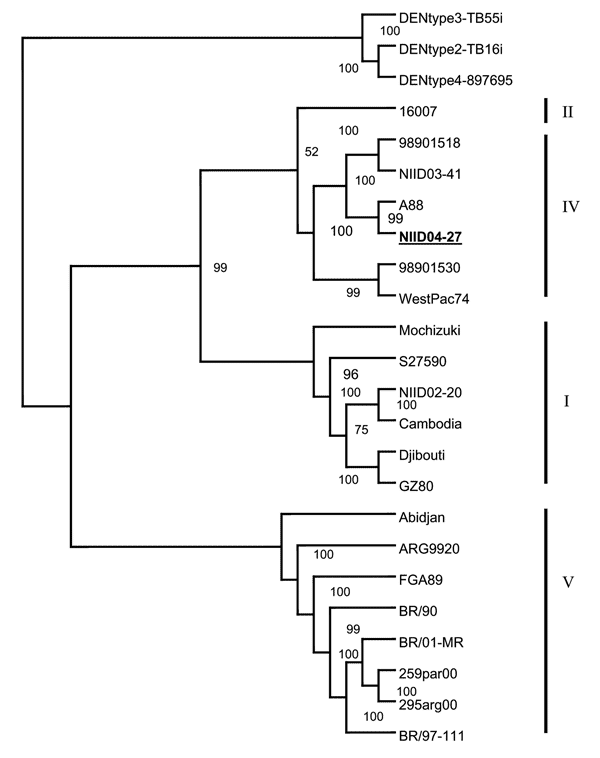Volume 12, Number 2—February 2006
Dispatch
Novel Dengue Virus Type 1 from Travelers to Yap State, Micronesia
Figure 2

Figure 2. Phylogenetic tree based on the full-length genome sequence of 21 available dengue virus (DENV) type 1 strains and DENV-2, -3, and -4. The multiple sequence alignments were obtained with ClustalX, and the tree was constructed by the neighbor-joining method. The percentage of successful bootstrap replicates is indicated at the nodes. The NIID04-27 strain is indicated in boldface. Genotypes I, II, IV, and V correspond to DENV-1 genotypes as defined by Goncalvez et al. (10).
References
- Takahashi M, Yamada K, Sato Y, Ikawa K, Matsumoto Y, Sano T, Detection of dengue virus-infected patients among passengers at the quarantine station of the New Tokyo International Airport. Jpn J Infect Dis. 2002;55:215–6.PubMedGoogle Scholar
- Chambers TJ, Hahn CS, Galler R, Rice CM. Flavivirus genome organization, expression, and replication. Annu Rev Microbiol. 1990;44:649–88. DOIPubMedGoogle Scholar
- Proutski V, Gritsun TS, Gould EA, Holmes EC. Biological consequences of deletions within the 3´-untranslated region of flaviviruses may be due to rearrangements of RNA secondary structure. Virus Res. 1999;64:107–23. DOIPubMedGoogle Scholar
- Markoff L. 5´-and- 3´-non coding regions in flavivirus RNA. Adv Virus Res. 2003;59:177–228. DOIPubMedGoogle Scholar
- Savage HM, Fritz CL, Rustein D, Yolwa A, Vorndam V, Gubler DJ. Epidemic of dengue-4 virus in Yap State, Federated States of Micronesia, and implication of Aedes hensilli as an epidemic vector. Am J Trop Med Hyg. 1998;58:519–24.PubMedGoogle Scholar
- Martin B. Dengue fever type 1 outbreak in Yap. ACTION n-20 2005; 11-2. [cited 2005 Nov 14]. Available from http://www.spc.int/phs/ENGLISH/Publications/InformACTION/IA20-contents.htm
- Barrero PR, Mistchenko AS. Complete genome sequencing of dengue virus type 1 isolated in Buenos Aires, Argentina. Virus Res. 2004;101:135–45. DOIPubMedGoogle Scholar
- Tajima S, Nukui Y, Ito M, Takasaki T, Kurane I. Nineteen nucleotides in the variable region of 3´ nontranslated region are dispensable for the replication of dengue type 1 virus in vitro. Virus Res. In press. Epub 2005 Oct 24.PubMedGoogle Scholar
- Goncalvez AP, Escalante AA, Pujol FH, Ludert JE, Tovar D, Salasa RA, Diversity and evolution of the envelope gene of dengue virus type 1. Virology. 2002;303:110–9. DOIPubMedGoogle Scholar
- Gritsun TS, Venugopal K, Zanotto PM, Mikhailov MV, Sall AA, Holmes EC, Complete sequence of two tick-borne flaviviruses isolated from Siberia and the UK: analysis and significance of the 5´ and 3´-UTRs. Virus Res. 1997;49:27–39. DOIPubMedGoogle Scholar
- Nam JH, Chae SL, Won SY, Kim EJ, Yoon KS, Kim BI, Short report: genetic heterogeneity of Japanese encephalitis virus assessed via analysis of the full-length genome sequence of a Korean isolate. Am J Trop Med Hyg. 2001;65:388–92.PubMedGoogle Scholar
- Shurtleff AC, Beasley DW, Chen JJ, Ni H, Suderman MT, Wang H, Genetic variation in the 3´ non-coding region of dengue viruses. Virology. 2001;281:75–87. DOIPubMedGoogle Scholar
- Holden KL, Harris E. Enhancement of dengue virus translation: role of the 3´ untranslated region and the terminal 3´ stem-loop domain. Virology. 2004;329:119–33. DOIPubMedGoogle Scholar
- Tilgner M, Deas TS, Shi PY. The flavivirus-conserved pentanucleotide in the 3´ stem-loop of the West Nile virus genome requires a specific sequence and structure for RNA synthesis, but not for viral translation. Virology. 2005;331:375–86. DOIPubMedGoogle Scholar
- Men R, Bray M, Clark D, Chanock RM, Lai CJ. Dengue type 4 virus mutants containing deletions in the 3´ noncoding region of the RNA genome: analysis of growth restriction in cell culture and altered viremia pattern and immunogenicity in rhesus monkeys. J Virol. 1996;70:3930–7.PubMedGoogle Scholar
Page created: February 02, 2012
Page updated: February 02, 2012
Page reviewed: February 02, 2012
The conclusions, findings, and opinions expressed by authors contributing to this journal do not necessarily reflect the official position of the U.S. Department of Health and Human Services, the Public Health Service, the Centers for Disease Control and Prevention, or the authors' affiliated institutions. Use of trade names is for identification only and does not imply endorsement by any of the groups named above.